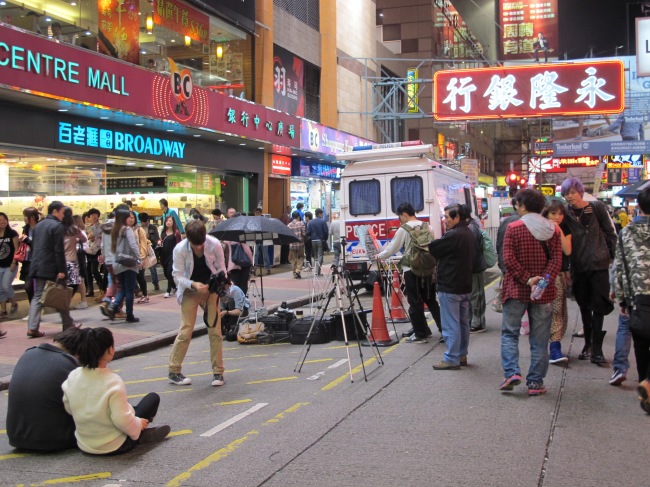Hawkers sale their products in name of doing art in the pedestrian area of Mong Kok.
By Sam Sum & Queen Tang
HONG KONG, April 11 – After since the law of obstruction in public place permitted the first street performance in public area, hawkers in Mong Kok pedestrian area run their business in name of doing art to escape from the prosecution.
A street performer Andrew So was charged by the obstruction in public places in April 2012, but he was not convicted because the judge thought that he was performing the culture of art.
Up to late December 2012, there are about 1690 unlicensed hawker in Hong Kong. Due to the law of Cap 228 Summary Offences Ordinance, Obstruction in Public Places – Section 4A, it is an offence if any person who without lawful authority or excuse sets out or leaves, or causes to be set out or left, any matter or thing which obstructs, inconveniences or endangers, or may obstruct, inconvenience or endanger, any person or vehicle in a public place. The highest penalty is a fine of $5,000 or to imprisonment for 3 months.
Michael Chan, who takes instant photos for sale in pedestrian area, said officers warned him that any unauthorized commercial activates are illegal in the pedestrian area, but after a hawkers nearby told him not to place any price tag, he never expelled by the officers again.
“Some tricky ways include not receiving cash directly, but letting customers put money in a box,” said Chan.
Mr and Ms Liu, who declined to disclose their name, sell handmade bronze accessories, they said officers warned them several times, but never did they get prosecuted. They argued they are performing art and displaying art pieces, but not retailing, therefore they are not illegal.
According to the Food and Environmental Hygiene Department, hawkers are required to apply the Fixed-pitch Hawker License, fixed pitch means any pitch including on the ground in any place or street. Hawker Control Teams are responsible for the management of hawkers.
Lon starts his photographing business few months ago.
Another photographer, Lon Chan, said the officers patrol every day, in the extreme case, they patrol seven to eight times a day.
“They prosecute us for selling and retailing, I need to leave when they patrol,” Lon said the patrolling affected him seriously, he described vendors like him are in dangerous situations now.
Customers hold different views on this issue. Kendall Marshal, visitor from England treated the stalls as kind of street performance, and disagreed the stalls had blocked the road.
“It’s cool,” said Marshal, “You can cross away the illegal things in Hong Kong, that’s why people like to come here, people behave themselves.”
However, local residents didn’t agree with that. Miss Yuen, Hong Kong resident who always go shopping in MongKok, she thought that the stalls created crowd and make the road difficult to cross.
“There are too many people in the road, I can’t even take a photo with my friends because people keep pushing us,” Yuen said government should organize the pedestrian area, like setting up the performances area or grouping the stalls in a designate area. She though the stalls took too many space and is not fair to the pedestrian.
“What they act in the district like hawkers selling pirated optical discs in the past decade,” Danny Wong, a policeman works in MongKok district, said that the loophole in the law of Obstruction in Public Places makes performers and hawkers perform and sale product ‘legally’.
Wong said that it is difficult to prosecute the hawkers by obstruction in public places because their acts can be defined as an art or cultural performance. The definition of obstruction is not clear, “the hawkers make the district narrower but people can still walk through it. That’s the tricky point for people to argue,” he said.


